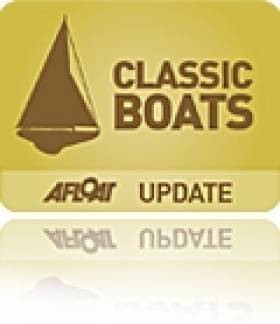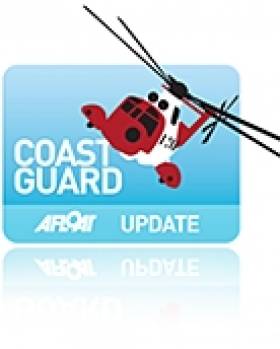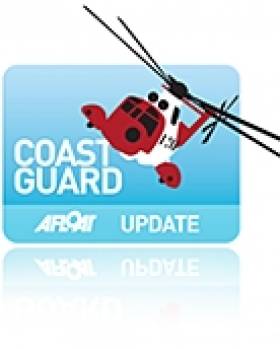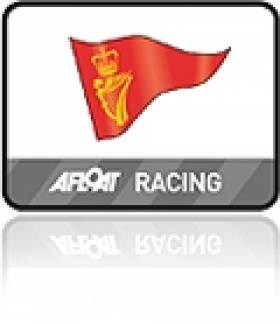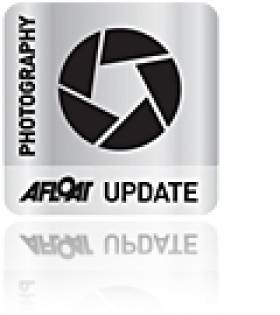Displaying items by tag: Glandore
#squib – 25 Squibs keelboats will compete for the first time for Southern Championship honours on July 19 at Glandore in West Cork. Ten visitors are expected to join a local fleet of 15 according to Glandore Harbour Yacht Club Commodore John Dowling.
#glandoreclassics – The 2013 CH Marine Glandore Classic concluded last weekend with the final prize-giving on the balcony of the Marine Hotel. The committee was delighted that the new format regatta was so well received by all throughout the week.
There was a fantastic turn out for the Parade of Sail on the opening weekend, the addition of cruise days to Baltimore and the Fastnet was well supported. The town of Baltimore put on a great reception for the Classic visitors and later in the week the trip to Castletownsend was also well supported on the water and at MaryAnne's.
While the stars for many were the appearance of Jolie Brise, "The Boat of the Regatta" award, and the lovely Fife Solway Maid "Concours de Regatta" award, the Commodore Diarmuid O'Donovan emphasized that it takes all the skippers crew and boats to make the regatta so successful and he thanked all participants and volunteers as he presented overall prizes for the nine divisions that participated in the regatta.
The Harbour fleets of Menai Straits Fifes, Dragons, Squibs, Ettes, Dayboats and Clinker classes were keenly raced over the six days with tie break winners in the Dragon and the Squib class.
In the Bay and Workboat classes Mike Walshe's 1979 Holman & Pye "Saidhbhear" won the Bay Class2 in the Gaffers Sean Walsh's "Tir na Nog" was the winner. The other new addition for this regatta was the Oar and Sail programme this got off to a very promising start with three of the Atlantic Challenge Bantry Boats and well as a number of raid type boats on the water and competing on the Saturday and Sunday, the regatta was delighted with their participation and hope to increase the Oar and sail programme for the 2015 Glandore Classic Regatta.
Exclusive Footage of Tit Bonhomme Rescue on RTÉ
#MARITIME TV PROGRAMMES - Footage from the rescue of the only survivor of the Tit Bonhomme tragedy in West Cork last January will feature in the first of a new series of Ireland's Search and Rescue tomorrow evening on RTÉ One.
Abdul Mohammed, 43, survived the sinking of the trawler when it ran around in rough seas near Adam's Rock at Glandore Harbour, after he was able to reach the shore.
His brother Wael Mohammed (35) died along with skipper Michael Hayes (52), Saied Ali Edlin (26), Attea Shaban (26) and Kevin Kershaw (21) when the boat went down.
As the Southern Star reports, Mohammed will feature in Sunday's programme talking to presenter Claire Byrne about his struggle to survive the tragedy, while exclusive footage from the Irish Coast Guard's Rescue 117 helicopter, the Irish naval vessel LE Niamh and Naval Service divers shows the search for the missing fisherman in the wake of the incident - a first for Irish television.
The first episode of the six-part series will be broadcast this Sunday 18 November at 6.30pm on RTÉ One.
Glandore Harbour Yacht Club Gets New Clubhouse
#GLANDORE HARBOUR - After 27 years, Glandore Harbour Yacht Club has finally acquired a clubhouse in the picturesque West Cork harbour village.
"It may have taken a long time but the reward is that we have ended up with a perfect location for our clubhouse," says Commodore Diarmuid O’Donovan in a message on the club website.
The new facility has been funded by a combination of fundraising from past events and a mortgage of €140,000. More fundraising is required to may off the mortgage while the club begins work on the premises to bring them up to fire and disability certification.
"We are a small but thriving club and I am sure this will show as we continue to fundraise for the better of the club," says O'Donovan.
"We have come a long way over the past few years. Membership has grown significantly. We also need to update our sail training fleet and equipment to facilitate the expansion of the club. Junior sailing is the lifeline and future of our club.
"It is wonderful to see the enthusiasm of all involved and I am sure the clubhouse will be a welcome asset for all sailors alike."
Commodore O'Donovan also thanks the club's members and supporters, as well as past and present committee members, for the time and effort they have given to date.
Body of Final Tit Bonhomme Crewmember Recovered
#NEWS UPDATE - The body of the last missing crewmember of the stricken Tit Bonhomme was recovered in Glandore Bay in West Cork on Friday, The Irish Times reports.
The remains of 23-year-old Egyptian national Saied Ali Edlin were discovered floating on the surface to the west of the bay off Long Point, almost a mile from the wreck site and close to a month after the tragedy occurred.
It also comes just two days after the body of skipper Michael Hayes was found close to the mouth of the harbour, as previously reported on Afloat.ie.
The fishing vessel Tit Bonhomme ran aground in rough seas near Adam's Rock, at the mouth of Glandore Harbour, on Sunday 15 January.
Five of the six-person crew - Eldin, Hayes, Attea Shaban (26), Kevin Kershaw (21) and Wael Mohammed (35) - lost their lives when the boat went down.
Only 43-year-old Abdul Mohammed, the brother of Wael Mohammed, survived the sinking after he was able to reach the shore.
"Some of those lost were Egyptian, some were Irish but if you fish the sea, you’re all part of the same family," commented harbour master John Minihane. "We’re all the same, we’re one fishing family and we brought them home.”
The Irish Times has more on the story HERE.
Search for Glandore Fishermen to be Wound Down
#NEWS UPDATE - The search for two fishermen still missing after their boat went down off West Cork nearly three weeks ago will be wound down next week, The Irish Times reports.
Search teams have been combing the area for any trace of Michael Hayes (35), skipper of the Tit Bonhomme, and crewman Said Mohammed (23) after the fishing vessel ran aground in rough seas near Adam's Rock, at the mouth of Glandore Harbour, on Sunday 15 January.
The bodies of Kevin Kershaw (21), Attia Shaban (26) and Wael Mohammed (35) were recovered in the days and weeks following the tragedy. Only one of the six-person crew - 43-year-old Abdul Mohammed – is confirmed to have survived.
As previously reported on Afloat.ie, last weekend saw more than 90 divers embark on an extensive search of the wreck site and the Glandore bay area, with hundreds more volunteers searching the coastline and on land.
Exclusion Zone Set Up Around Wreck of Fishing Vessel 'Tit Bonhomme'
#GLANDORE TRAWLER – In the interest of safety and to facilitate any search and recovery operations in the vicinity of the sunken vessel the F.V. TIT BONHOMME, the Department of Transport, Tourism and Sport has set up an exclusion zone has been created around the vicinity of the vessel.
Divers are expected to resume the search for five missing fishermen from the vessel this morning.
The vessel lies between Adam and Eve Islands in the approaches to Glandore Harbour, County Cork.
Only vessels and persons authorised by the Irish Coast Guard (IRCG) are permitted to enter this area, which lies within a 200 metre radius, centred on the wreck in approximate position:
51° 32'.4 N, 009° 06'.1 W.
Accordingly, for safety reasons, all other vessels in the vicinity are requested to keep clear of the exclusion zone and give this area a wide berth.
The exclusion zone will continue until further notice.
IRCG may be contacted at Valentia Marine Rescue Sub-Centre, tel: +353 (0)66 9476109.
#RESCUE – Naval divers are searching a sunken Irish registered vessel for three missing people off Glandore harbour Co. Cork this morning. An operation is underway after a distress call was made at 6 am. Six people were on board and five are still missing from the vessel 'Bonhomme' that sank in 11m of water. A distress call was made just before 6am. The trawler is understood to have been making its way home in force 7 to 8 south-easterly winds when the alarm was raised. The Coastguard and a number of lifeboats are involved in the search. One crew man has been taken to hospital.
Royal Cork Boats were well represented today (Sun) at Glandore Harbour Yacht Club At Home writes Claire Bateman. Mediterranean conditions prevailed with sun, wind and sparkling blue water. When conditions such as existed today prevail this is a little piece of paradise tucked away in West Cork surrounded by glorious scenery. It was apt that they were rewarded with these conditions for the celebration of their 25th anniversary. The mouth of the harbour is marked by the Adam and Eve Islands and the cruisers had a start south east of this point using Neil Prendeville's Mary P as committee boat and a race officer team that included event organiser Cormac O'Carroll. The 16 knot breeze outside the harbour was from the south west, while inside the harbour there was a lighter breeze that one would guess was more from the north west and this was where the Squibs were sailing their two day championship.
The club is a hive of activity in furthering its amenities and they are very actively raising funds for a new club house. They had a raffle for a new car on offer today to further this project. Also they had a novel event of a Pig Roast-Barbeque with great music by the Roaring Forties and were looking forward to a great night of entertainment.
Glandore Yacht Club 'At home' Photography
A gallery of summer sailing photos from Glandore Yacht Club has been added to the Afloat gallery by Bob Bateman. Take a click through some lovely images of West Cork sailing. Click here.



























